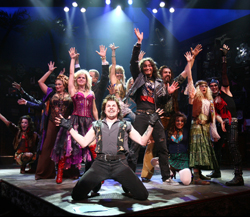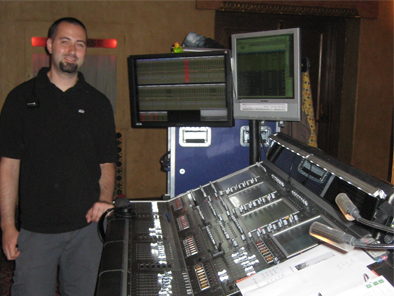
Hair: The Revival of the American Tribal Love-Rock Musical
Hair was 1969’s Best Musical. “Aquarius,” “Let the Sunshine In,” “Hair,” “Good Morning Starshine” and “Easy to Be Hard” became top singles, covered by artists of the day.
After marking its 40th anniversary in September 2007 with three shows in Central Park, it returned the following summer for a hugely successful four-week engagement and the Broadway revival opened last March, returning as 2009’s Best Revival.
The Al Hirschfeld Theater (cap. 1,437) seats about 850 on the orchestra level and half as many upstairs. Sound design for Hair is by Acme Sound Partners’ Sten Severinson, who did much of the work in Central Park, and Nevin Steinberg, with audio equipment provided by Sound Associates of Yonkers.
Scott Sanders mixes on a DiGiCo D5-T with the 16-fader TC theater control surface. The show’s 30 songs and multiple characters require upwards of 10 of the D5T’s 16 VCAs to be assigned to vocals for each scene.
Outboard effects include five TC Electronic M-3000 reverbs and a Lexicon 960 configured with two engines employed for surround effects. Q-Lab supplies impressive sound effects running on a pair of Mac Minis each with a pair of MOTU UltraLite interfaces for 16 channels of playback.
A center cluster of a dozen L-Acoustic d-VDOSC reinforces the vocals, with a single ARCS and a CQ-1 on each side of this array for the band, all hidden behind a scrim. On each side of the stage is a pair of ARCS for band reinforcement, with a Meyer Sound UPA-2P beside it for vocals, covering the orchestra level. A platform over this loudspeaker position is used frequently by actors entering and leaving the stage via the balcony.
Up higher for the balcony, another ARCS again reinforces the band, with an L-Acoustic 108P for vocals. Beside these a single L-Acoustic 112P covers the extreme offstage balcony seats.
The balcony is amply covered from a Front of House truss with left and right arrays of four Meyer MICAs below a 600HP subwoofer for the band and a single Meyer CQ-1 at the center for vocals. Since the band is on stage, there are four more 600HP subwoofers in the pit.
Under-balcony loudspeakers consist of two rows of eight d&b E-3 loudspeakers, and EAW JF80 loudspeakers are used for the show’s substantial surround effects.
The naked brick back wall of the theater is painted in a ’60s op art sunrise and the only set on stage is the band. Drummer Bernard Purdie, who played in the 1969 original, sits on the back of a green 1955 GMC half-ton pickup, with the bass and guitar players on platforms over its cab and hood, and keyboards and percussion on a riser beside it.

Monitors are mixed by Jim Wilkinson from a DiGiCo D1 on stage-right, consisting of a Meyer UM-1 for the bass player and UPM-2s for keyboards, and newer UPM-2Ps for percussion, drums and guitars. The five-piece horn section seated on a back-wall catwalk just above them, shares three EAW JF60s.
.
On stage, three more JF60s are recessed under the floor behind steel grilles down-stage center, plus four more behind grills upstage. Overhead at mid-stage, a four-box Meyer M1D array pointed straight down creates a large sweet spot that the cast clearly enjoy.
Bonnie Runk and Michelle Guttierez assist on deck with radio mics and there are 18 Sennheiser EM-3532 receivers above the stage-right monitor position with the new Sennheiser SK-5212 micro-miniature transmitters that have become the latest standard on Broadway, and can be hidden in hair when there’s no wardrobe.
DPA 4066 headset mics provide a great audio advantage and freedom of movement for a cast that not only has multiple entrances and exits from the audience, but often performs from the house as well, with some lines delivered right beside loudspeakers.
